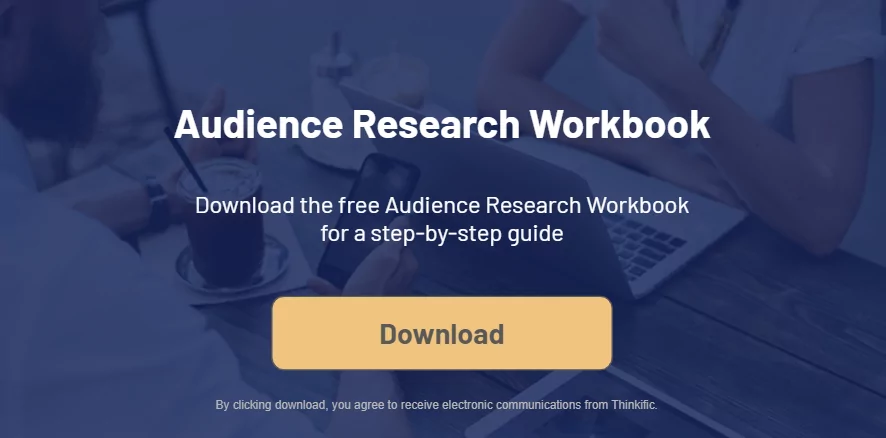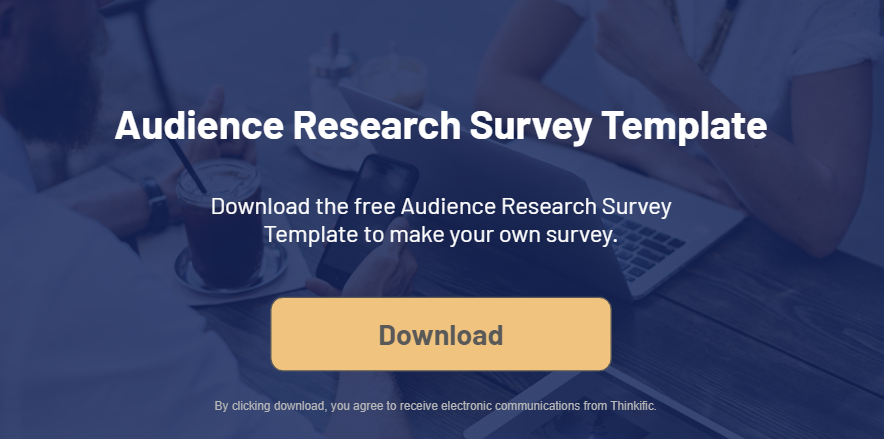If you’re setting up a business, an essential first step is getting to know your target audience. Before you begin any branding or marketing activities, take some time to find out who your target audience is and what solutions they’re looking for.
Find out how to define your target audience and top tips and templates to make the process easier.
What is a target audience?
Your target audience is the specific group of people who are most likely to want to purchase your product or service. These are the people your marketing should be aimed at.
Your target audience will be defined by demographics, the challenges they’re facing and the solution they’re hoping to find.
Why is it important to define your target audience?
Before you create a product, it’s essential to know to who you want to sell it.
By having a clear idea of the wants and needs of your customers, you can create a product that will actually help them. Rather than trying to find customers to fit your products, the idea is to fit your product to your ideal customer.
Remember that even if your product has several different target audiences – your target audience is not everyone!
Where many entrepreneurs and brands go wrong is making their target audience too big. For example, “My product is aimed at all men” or “This product is for teenagers”. This is a great starting point but you need to refine your target audience to make your marketing effective.
Get the free Audience Research Workbook with a step-by-step guide to defining your target audience.
Target audience roles
If you’re still learning how to define your target audience, bear in mind that there are different purchase roles.
Purchase roles divide your target audience according to how much influence they have over the final purchase decision. There are two core purchase roles: the supporter and the decision-maker.
The supporter
The supporters in your target audience do not have the power to make the final purchase decision but they have a strong influence on the person who does. While they will not be responsible for handing over the money, their opinion on your product matters.
A good example of the supporter role is a child picking out their Halloween costume. Alternatively, an HR employee evaluating training programs is also a supporter.
The decision-maker
The person with the ultimate decision over whether or not to make a purchase is the decision-maker. They have a direct influence on whether or not an item or service is purchased. Sometimes the decision-maker may not be who you assume so make sure you base your understanding off of your target audience research, not your gut feeling.
To use the same example, the decision-maker is the parent buying the child’s costume or the CEO having the final call on employee training.
When you define your target audience, it’s important to take into account the different purchase roles.
How to define your target audience
Ready to define your target audience? Follow these 5 steps.
Ask your current customers
If you want to find out more about your target audience, start with your current customers. You can conduct audience research by utilizing your email list, social media followers, and site visitors. Give customers the option to take part in a survey or schedule a time for a one-to-one call where you can interview them on their needs and pain points.
Get details on demographics
To understand more about who’s most likely to buy your products or services, try to define the demographics of your current audience.
Here are some key demographics to look out for:
Age
One of the most basic demographic factors is the age of your target audience. Age can tell you a lot about the types of content and channels your target audience is most likely to engage with.
Don’t worry about being too specific here. Your target audience might be a range of ages or generation-based. You might also find that you have multiple bands of ages within your target audience. For instance, you might want to target both Gen Z and Millennials with your products.
Gender
Another important demographic to understand is gender. Gender can have a big influence on where you direct your marketing efforts, as well as your choice of messaging and brand identity.
For example, in 2021 71% of Pinterest users were female whereas 61% of Twitter users were male. Knowing the gender ratio of your target audience can have significant sway on your choice of marketing channels.
Income
It’s also helpful to get an understanding of your target audience’s household income in order to estimate their spending power. How much disposable income do they have? How much can they afford to pay for your product or services? These factors will all influence how you market your product or services and your pricing strategy.
Location
When you’re carrying out audience research, find out where in the world your target audience is based. This will help you to understand which geographic regions to target and even which languages to use for your product or services.
For instance, if your audience is based in the majority Spanish-speaking countries, you might consider creating resources and content in Spanish as well as English.
Relationship, marital, or family status
Depending on your product, it can also be helpful to know your target audience’s relationship status, marital status, or family profile. Are most of your customers married? Divorced? Parents? These factors can all affect the types of products or services that your audience is interested in and what content and ads they respond to.
Interests
You can also define your target audience according to their interests. Try to find out their hobbies, entertainment preferences, and more. How do they like to spend their free time? How much time and money do they invest in their hobbies? Are they pet lovers, extreme sportspeople, or bookworms?
Pick out common hobbies and interests in your target audience to inform your marketing in the future. This also gives you the opportunity to find potential tie-ups with other brands and influencers you might want to work with in the future.
Understand their needs and pain points
As well as getting to grips with the demographics of your target audience, you also need to go a little deeper. When you’re trying to define your target audience, make sure you explore their needs and pain points too.
What is your target audience struggling with? What are their 3 top fears? What keeps them up at night? Focus on the common worries of your target audience – as they relate to your niche – and don’t be afraid to get specific. The more detail you can get on your target audience’s needs, challenges, and fears, the more you can make sure that your product or service solves them.
Understanding this aspect of your target audience is essential not only for your marketing but also for your sales strategy and brand story. If you’re a course creator, it could have a huge impact on what content you include in your course too.
Analyze the solution they’re hoping for
Next up, you need to understand how you’re going to position your product or service in relation to your audience’s needs. This involves looking at the solution(s) that your target audience is hoping for.
What results is your target audience hoping to achieve? What steps do they need to take to get there? How does your product address those needs? How can your unique offering provide a solution to their problems?
Finding out the dream solution for your target audience will help you to get a more detailed profile of your customers that can influence your marketing going forward.
Create a customer avatar
The last step to help you define your target audience is to make a customer avatar. Distill the commonalities that your best customers have in common and put them all into one person. What are the characteristics of your ideal customer? This is the point where you can create your perfect customer profile, based on your audience research.
A customer avatar is hugely helpful for targeting your marketing. The aim is to have one individual in mind. When you create marketing assets in the future, it will all be directed at this one person. This will help you write for your audience in a more personal and meaningful way.
The trick to making your marketing resonate is to imagine, you’re talking to a single individual and their needs, worries, hopes, and dreams.
Download the Customer Avatar workbook to create your customer avatar.
Related: How To Create Your Ideal User Persona To Focus Your Efforts (+3 Templates)
How to gather information on your target audience
If you want to define your target audience, start by looking at your existing customer base.
The easiest way to understand who your target audience is to ask them! Audience research is the most effective way to get to grips with your target audience and figure out who they are and what they want.
If you’re just starting out or you’re a small or medium business, there are two methods that are most effective: surveys and interviews.
Surveys
Surveys are a really useful starting point for customer research. They can be sent out via email or social media – whichever channel you use to communicate with your audience most regularly.
Try one of these methods:
- Run a poll on Twitter, Facebook, or Instagram
- Post a question on your private Facebook Group
- Ask questions on your Instagram stories
You can also use a tool like Typeform to make your survey and send the link via email.
Download the free Audience Research Survey Template to make your own survey.
Survey questions
The quality of any survey depends on asking the right questions. Here’s what to include in your audience research survey.
Demographic questions
In your audience research survey, make sure you get information about your respondents’ demographics.
This should include questions on:
- Age
- Gender
- Location
- Education
- Household income
It’s a good idea to format your demographics questions as multiple-choice questions.
Long-form questions
Your survey should also include long-form questions that help you to delve into their needs and desires.
Here are some good examples:
- What do you struggle with most when it comes to X?
- How does it make you feel?
- Why is it important for you to solve X right now?
- If you took a course on X, what would you like to walk away with by the end of it?
Long-form questions are useful here as they help you to get a more detailed, individualized picture of your customers’ needs.
Evaluate your survey findings
Once you’ve sent out your survey and have received at least 10 responses, it’s time to analyze your findings.
Review the responses in your surveys and pick out common themes and keywords. This will help you to identify shared struggles among your audience. You will also be able to understand what solutions they’re looking for and how your products or services might fill that need.
Download the Audience Research Workbook for a step-by-step guide on how to analyze your survey findings.
Interviews
Interviews are another ideal method for helping you to define your target audience. If you can have a one-to-one conversation with your customer, you can get an extra detailed profile of their needs and wants. This also gives you the chance to connect with your existing customers on a personal level.
If possible, record the conversation – make sure you ask for permission first – and take detailed notes. When you’re talking to someone you’ll get a lot of information fast, so you’ll need help remembering all the details!
3 step interview process
Choose your technology
- Use a scheduling application like Calendly to allow customers to schedule a time for the call
- Connect a video conferencing application e.g. Zoom, Google Meet or Whatsapp
- Send your customers an automatic link via the scheduler
Write an email to your audience
- Give your email a catchy subject line e.g. “Hey [name], can we chat?”
- Ask them to use the scheduling link
- Offer an incentive like a prize draw or coupon to encourage more sign-ups
Write your interview questions
- Introduce yourself and explain the purpose of the call
- Write open-ended questions e.g. “What are your main challenges with [topic]?
- Dig deeper into your interviewee’s answers
- Add questions that reveal the emotional motivations behind their answers
Download the Audience Research workbook for more sample interview questions and tips on interviewing techniques.
Analyze your interview answers
As with your surveys, you also need to analyze your interview answers to find common themes among your target audience. Look for words, themes, and phrases that are shared between the group and repeated often.
You can also draw out similarities in the challenges and pain points your customers are experiencing to get a more complete picture of your target audience.
Extra tips to define your target audience
When it comes to how to define your target audience, there are a few other tricks to keep up your sleeve. These tips will help you to refine your understanding of your target audience and how it changes over time.
1. Check out your competitors
As well as talking to your current customers, another great resource for finding your target audience is competitor research. Check out who your competitors are targeting and who is buying their products.
Many brands list their top clients on their homepage or you can check out their social media followers and influencer partnerships. By utilizing competitive analysis, you can learn how your competition works, who their target audience is, and where you can potentially outmaneuver them to win new customers.
2. Utilize social media
Social media analytics is a hugely useful tool to use in your customer research. Social media is designed to help marketers understand and analyze their audiences and there’s a whole range of tools that make it easy to do just that.
If you already have social media channels set up for your business, you can use these to help you define your target audience.
Social analytics
Every social media platform has a way for you to analyze your audience and what’s working for you. With social analytics, you can also see where your traffic is coming from, what content your audience is engaging with, and key demographics.
Social listening
You can also try using social listening as a way to better understand your target audience. Dig deeper into the interests of your audience by looking at keywords and hashtags that they’re using. You can find relevant topics that fit with your niche and that have an overlap with your brand.
This is a good way to see who’s talking about your products or services and where they fit amongst your competitors. Which brands are your target audience loving right now? What conversations are they having around your industry? What new trends are emerging?
Social media is a powerful resource to learn more about what’s important to your audience. Crucially, it’s not just for big brands. Entrepreneurs and small businesses can take advantage of it too!
3. Keep working on it
Understanding your target audience is never a one-time activity. This is something you need to do regularly to get a clear picture of who your audience is and what they need. The more customers you get, the more detailed a profile you can build.
You might also find that your target audience shifts as your brand develop. Your products might appeal to new demographics or target different pain points for your audience over time so it’s a good idea to use surveys and interviews periodically to keep up-to-date.
Ready to define your target audience?
To make your marketing as effective as possible, it’s important to define your target audience. This is especially key in the age of digital advertising and social media. If you want to get your content in front of the right people, you need to know who those people are.
Having a clear picture of your target audience is the best way to create marketing content that is going to speak to potential customers and get more conversions down the line.
To learn more about the best marketing strategies for your business, take our Free Webinar Sales Funnel course.
This article was originally published Nov, 2021 and was updated July 2022 with even more helpful resources.





